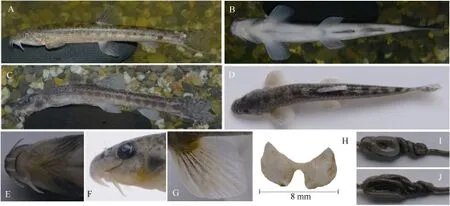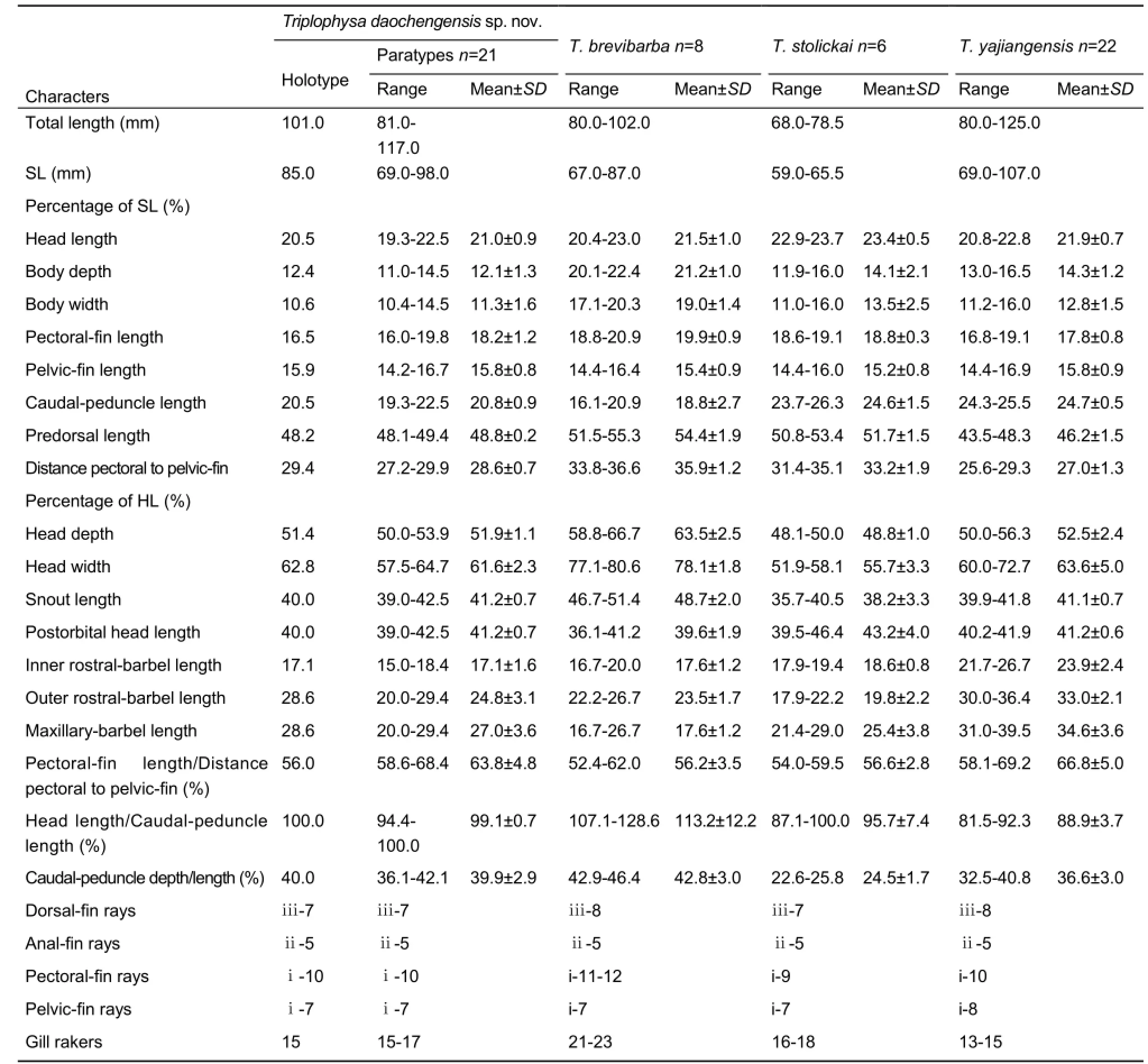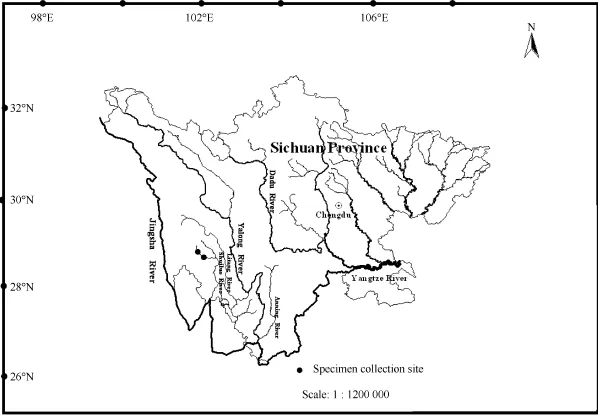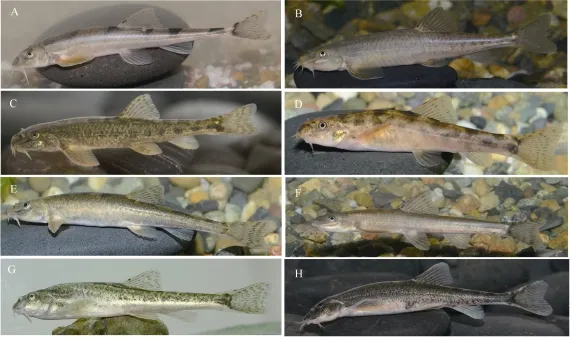A new species of the genus Triplophysa (Cypriniformes:Nemacheilidae), Triplophysa daochengensis, from Sichuan Province, China
2016-11-15YuYiWUZhiYuSUNYanShuGUO
Yu-Yi WU, Zhi-Yu SUN, Yan-Shu GUO,*
1College of Life Sciences, China West Normal University, Nanchong Sichuan 637009, China
2Sichuan Academy of Forestry, Chengdu Sichuan 610081, China
A new species of the genus Triplophysa (Cypriniformes:Nemacheilidae), Triplophysa daochengensis, from Sichuan Province, China
Yu-Yi WU1, Zhi-Yu SUN2,*, Yan-Shu GUO1,*
1College of Life Sciences, China West Normal University, Nanchong Sichuan 637009, China
2Sichuan Academy of Forestry, Chengdu Sichuan 610081, China
Triplophysa daochengensis sp. nov. is described from the Daocheng River, a northern tributary of the Jinsha River in Sichuan Province, China. The new species can be distinguished from its congeners by the following characters: body smooth and scales absent; lateral line complete; caudal peduncle compressed, depth unchanging; head length equal to caudal-peduncle length; lower jaw shovel-shaped;dorsal-fin origin anterior to pelvic-fin origin and closer to the tip of the snout than to the caudal-fin base, last unbranched ray hard; pelvic-fin tip not reaching anus; posterior chamber of gas bladder absent; intestine of spiral type with three winding coils.
Nemacheilidae; Triplophysa; New species;Sichuan
lNTRODUCTlON
The genus Triplophysa is wide spread on the Qinghai-Tibet plateau and in adjacent areas. In total, 127 species of Triplophysa have been reported, with 109 occurring in China (Yan et al., 2015). Triplophysa can be distinguished from other Nemacheilidae genera by the character combination of close together nostrils, and sexual dimorphism in which males have patches of tubercles on both sides of the head and an agglomeration of tubercles on the dorsal surfaces of the branched and broadened pectoral-fin rays (Yang et al., 2011).
The Jinsha River from Yushu in Qinghai to Yibin in Sichuan marks the upper reaches of the Yangtze River. Twenty species of Triplophysa have been recorded from the Jinsha River basin so far: Triplophysa aquaecaeruleae, T. anterodorsalis, T. bleekeri, T. brevibarba, T. brevicauda, T. daqiaoensis, T. grahami, T. hialmari, T. leptosoma, T. markehenensis, T. ninglangensis, T. orientalis, T. pseudostenura, T. stenura, T. stolickai, T. venusta, T. xichangensis, T. xiqiensis, T. yajiangensis and T. yaopeizhii(Ding, 1993; Ding & Lai, 1996; Guo et al., 2012; He et al., 2012;Prokofiev, 2001; Wu & Wu, 1992; Xu & Zhang, 1996; Yan et al.,2015; Zhu, 1989).
From March 1995 to June 2015, we collected 2 959 specimens of nemacheilid loaches in the Jinsha River basin. Comprehensive study of these specimens and detailed comparison with species previously recorded from the Jinsha River (Ding, 1993; Ding & Lai, 1996; Guo et al., 2012; He et al.,2012; Prokofiev, 2001; Wu & Wu, 1992; Xu & Zhang, 1996; Yan et al., 2015; Zhu, 1989) unveiled a new species, which is described herein.
MATERlALS AND METHODS
Specimens were captured using hand nets and fish traps. The geographic coordinates of the specimen collection sites were obtained using a GPS Garmin eTrex handheld device. Specimens were fixed in a 10% formalin solution in the field,and after 5 d were transferred into a 5% formalin solution for long-term storage. Measurement methods followed Wu & Wu(1992) and Prokofiev (2007) and were made with digital calipers recorded to its nearest 0.1 mm. Lateral head length was from snout tip to the most posterior point of the opercle.
Abbreviations used in this paper are: SL, standard length; HL,lateral head length; CWNU, College of Life Sciences, China West Normal University, Nanchong, China; KIZ, Kunming Institute of Zoology, Chinese Academy of Sciences, Kunming,China; IHB, Institute of Hydrobiology, Chinese Academy of Sciences, Wuhan, China.
RESULTS
Triplophysa daochengensis sp. nov. (Figures 1)
Holotype: CWNU 201406001, male, 85.0 mm SL; Daocheng River, at Shengmu Village, Daocheng County, Sichuan Province, China; N29°02′55″, E101°30′45″; 3 540 m a.s.l.;collected by Yan-Shu Guo, Jun Yang, and Ming-Hao Luo on June 16, 2014.
Paratypes: 21 specimens, 69.0-98.0 mm SL. CWNU 201006001-006 collected by Yan-Shu Guo on June 01, 2010;CWNU 201406002, KIZ 2014005963, IHB 201406004, CWNU 201406005-201406006, KIZ 2014005964, CWNU 201406008-201406009 collected by Yan-Shu Guo, Jun Yang, and Ming-Hao Luo on June 16, 2014; same collection site as the holotype. IHB 201406010, CWNU 201406011-201406014, KIZ 2014005965, IHB 201406016 collected by Yan-Shu Guo, Jun Yang, and Ming-Hao Luo on June 16, 2014; the collection site was a wetland by the Daocheng River, at Chahua Village,Daocheng County, Sichuan Province, China; N29°02′04″,E100°23′43″; 3 700 m a.s.l.

Figure 1 Triplophysa daochengensis sp. nov.A, B, D, E, F, G: holotype, CWNU 201406001, 85.0 mm SL, male (A: lateral view, life coloration; B: ventral view; D: dorsal view; E: ventral view of head;F: lateral view of head; G: pectoral-fin); C: paratypes, CWNU 201406012, 92.0 mm SL, female, lateral view; H: paratype, CWNU 201006006, 96.8 mm SL, male, air bladder; I and J: paratype, CWNU 201406008, 95.5 mm SL, female (I: ventral view of intestines; J: dorsal view of intestines).
Diagnosis: Body smooth and scales absent; lateral line complete; caudal peduncle compressed, depth unchanging; head length equal to caudal-peduncle length; lower jaw shovel-shaped;dorsal-fin origin anterior to pelvic-fin origin and closer to the tip of the snout than to the caudal-fin base, last unbranched ray hard;pelvic-fin tip not reaching anus; posterior chamber of gas bladder absent; intestine of spiral type with three winding coils.
Description: Morphometric and meristic characteristics are provided in Table 1. Body elongate, caudal peduncle compressed and depth to caudal fin direction unchanging. Body surface smooth and scaleless. Lateral line complete with 86-95 pores. Vertebrae 4+40 (n=2).
Snout blunt, with length equal to postorbital head length. Anterior and posterior nostrils located adjacently and close to anterior rim of orbital. Mouth inferior. Lips thick and furrowed;upper lip without a median incision; lower lip with v-shaped central notch; lower lip surface with shallow furrows. Lower jaw shovel-shaped, with a sharp edge, not covered by lower lip. Inner rostral barbel not extending to corner of mouth, outer rostral barbel extending to a vertical through nostril, maxillary barbel reaching a vertical through posterior margin of eye.
Dorsal fin with a concave distal margin, last unbranched ray hard. Dorsal-fin origin anterior to pelvic-fin origin and closer to the tip of the snout than to the caudal-fin base. Pectoral-fin tip exceeds the midpoint between pectoral and pelvic-fin origins. Pelvic-fin tip not reaching anus. Anal fin with straight distal margin. Caudal-fin deeply emarginate, lower lobe slightly longer than the upper one.
Gas bladder with an anterior chamber fully enclosed in bony capsule; posterior chamber absent. Stomach “u”-shaped. Intestine winding spiral type with three coils.
Color pattern in life: Color of the dorsum and flanks yellowishbrown, abdomen white. Eight to twelve black brown transverse saddles on back, 10-16 black spots on the side of the body post-medianly. All fins grayish yellow. Two to three transverse rows of small black spots on the dorsal fin and 2-4 rows of small dark spots on the caudal fin.
Color pattern of preserved specimens: Dorsum and flanks gray, abdomen whitish beige. Eight to twelve black transverse saddles on dorsum and 10-16 black spots on the side of the body post-medianly.
Sexual dimorphism: Upper and lower patch of tubercles in pre- and suborbital areas in males; upper patch is a short strip skewed upwards located sub-antero-orbitally; lower patch is triangle-shaped and located at the base of the maxillary barbel in front of the operculum. In males, the first to sixth branched pectoral-fin rays possess a patch of tubercles dorsally; pectoralfin is shorter but wider than in females.

Table 1 Main morphometric and meristic characters of T. daochengensis sp. nov., T. brevibarba, T. stolickai and T. yajiangensis
Distribution: Currently known in Daocheng River, a northern tributary of the Jinsha River in Sichuan Province, and its associated wetlands (Figure 2).
Ecology: Inhabits areas close to river banks and wetlands with slow water current bottom composed of gravel and mud;submerged waterweeds present (Figure 3). Algae and aquatic invertebrates were found in the stomachs of six dissected specimens. Several other species were collected at the same time: T. stolickai, T. brevicauda, Misgurnus anguillicaudatus,Schizothorax kozlovi and Schizopygopsis malacanthus.
Etymology: The specific name is derived from its collection location in Daocheng County.
DlSCUSSlON
Triplophysa daochengensis can be distinguished from T. orientalis, T. xichangensis, T. venusta, T. obscura, T. pseudoscleroptera, and T. scleroptera by lower jaw shovelshaped vs. spoon-shaped and posterior chamber of the gas bladder absent vs. present (Ding, 1994; Wu & Wu, 1992; Zhu,1989; Zhu & Wu, 1981).

Figure 2 Collection site of Triplophysa daochengensis sp. nov.

Figure 3 Habitat of Triplophysa daochengensis sp. nov.Mainstem and backwaters of the Daocheng River, Daocheng County, photograph taken on June 16, 2014.
Triplophysa daochengensis can be distinguished from T. aquaecaeruleae, T. bleekeri, T. brevicauda, T. daqiaoensis, T. grahami, T. leptosoma, T. ninglangensis, T. pseudostenura, T. xiqiensis, T. yaopeizhii, T. angeli, T. pappenheimi, T. robusta,and T. siluroides by lower jaw shovel-shaped vs. spoon-shaped and intestines of winding spiral type with three coils vs. one zigzag loop (Ding, 1993, 1994; Ding & Lai, 1996; Guo et al.,2012; He et al., 2012; Prokofiev, 2001; Wu & Wu, 1992; Xu & Zhang, 1996; Zhu, 1989).
Triplophysa daochengensis, T. alexandrae, T. hialmari, T. stenura and T. lixianensis share a shovel-shaped lower jaw, but the caudal-peduncles of T. alexandrae, T. hialmari, T. stenura,and T. lixianensis are round and taper obviously vs. compressed and depth unchanging (Figure 1, Figures 4A, H)(Chen et al., 2004; Ding, 1994; He et al., 2008; Prokofiev, 2001;Wu & Wu, 1992; Zhu, 1989).
Triplophysa daochengensis and T. anterodorsalis share a shovel-shaped lower jaw, but can be distinguished by last unbranched dorsal-fin ray hard vs. soft; caudal-fin deeply emarginate vs. emarginated; intestine of spiral type with three winding coils vs. one zigzag loop; pectoral-fin length/distance from pectoral to pelvic-fin 58.6%-68.4% vs. 68.7%-89.8%; and postorbital head length equal to snout length vs. shorter than snout length (Figure 1, Figure 4D) (Ding, 1994; Yan et al., 2015;Zhu, 1989).
Triplophysa stolickai, T. crassilabris and T. daochengensis share a shovel-shaped lower jaw; however, T. stolickai and T. crassilabris can be distinguished from T. daochengensis by the last unbranched dorsal-fin ray soft vs. hard; dorsal-fin origin further to the tip of the snout than to the caudal-fin base vs. vice versa; pelvic-fin tip reaching or exceeding the anus vs. not reaching the anus (Table 1, Figure 1, Figures 4E, G) (Chen et al., 2004; Ding, 1994; Wu & Wu, 1992; Zhu, 1989).

Figure 4 Eight related species of Triplophysa daochengensis sp. nov.A: T. stenura (CWNU 201407006, 98.5 mm SL, male); B: T. brevibarba (CWNU 201112079, 92.5 mm SL, male); C: T. markehenensis (CWNU 201108021, 83.2 mm SL, male); D: T. anterodorsalis (CWNU 201112066, 69.2 mm SL, male); E: T. stolickai (CWNU 201406069, 65.5 mm SL, male); F:T. yajiangensis (CWNU 201407001, 107.0 mm SL, female). G: T. crassilabris (CWNU 200807036, 68.5 mm SL, male); H: T. lixianensis (CWNU 201108032, 103.5 mm SL, male).
Triplophysa daochengensis and T. markehenensis share a shovel-shaped lower jaw, but can be distinguished by the posterior chamber of the gas bladder being absent vs. present;dorsal-fin origin nearer to the tip of the snout than to the caudalfin base vs. vice versa; caudal-peduncle depth to caudal fin direction unchanged vs. slightly decreasing; and pelvic-fin tip not reaching the anus vs. reaching or exceeding the anus(Figure 1, Figure 4C) (Wu & Wu, 1992; Yan et al., 2015; Zhu,1989; Zhu & Wu, 1981).
Triplophysa daochengensis can be distinguished from T. yajiangensis by caudal-peduncle depth to caudal-fin direction unchanged vs. slightly decreasing; pelvic-fin tip not reaching the anus vs. reaching or exceeding the anus; and head length equal to caudal-peduncle length vs. shorter than caudalpeduncle length (Table 1, Figure 1, Figure 4F) (Yan et al., 2015).
Triplophysa daochengensis can be distinguished from T. nujiangensa by snout length equal to postorbital head length vs. shorter than postorbital head length; predorsal length 48.1%-49.4% of SL vs. 71.1%-77.2%; last unbranched dorsal-fin ray hard vs. soft; pectoral-fin length/distance from pectoral to pelvicfin 58.6%-68.4% vs. 47.5%-63.5%; and caudal-peduncle depth to caudal-fin direction unchanged vs. slightly decreased (Chen et al., 2004).
Triplophysa daochengensis can be distinguished from T. tanggulaensis by head length equal to caudal-peduncle length vs. longer than caudal peduncle; last unbranched dorsal-fin ray hard vs. soft; pelvic-fin tip not reaching the anus vs. exceeding the anus; vertebrae 4+40 vs. 4+37-38; and rakers on the inner side of the first branchial arch 15-17 vs. 10-13 (Zhu, 1989;Chen et al., 2004).
Chen XY, Cui GH, Yang JX. 2004. A new fish species of genus Triplophysa(Balitoridae) from Nu Jiang, Yunnan, China. Zoological Research, 25(6):504-509. (in Chinese)
Ding RH. 1993. Two new species of the Genus Triplophysa from western Sichuan (Cypriniformes: Cobitidae). Acta Zootaxonomica Sinica, 18(2):247-251. (in Chinese)
Ding RH. 1994. The Fishes of Sichuan, China. Chengdu: Sichuan Science and Technology Press, 63-95. (in Chinese)
Ding RH, Lai Q. 1996. A new species of Triplophysa from Sichuan. Acta Zootaxonomica Sinica, 21(3): 374-376. (in Chinese)
3.支出明细表的其他支出栏目占比较大。部分高校填报时,其他支出占比超过30%时,未作合理的说明,主要原因核算过于粗糙,不细化到具体的功能科目上。
Guo YS, Sun ZY, Fu JR, Liu SY, Guo ZW, Yang J. 2012. Found once more and annotation on the type locality of Triplophysa angeli. Acta Zootaxonomica Sinica, 37(4): 912-914. (in Chinese)
He CL, Song ZB, Zhang E. 2008. Triplophysa lixianensis, a new nemacheiline loach species (Pisces: Balitoridae) from the upper Yangtze River drainage in Sichuan Province, South China. Zootaxa, 1739: 41-52.
He CL, Zhang E, Song ZB. 2012. Triplophysa pseudostenura, a new nemacheiline loach (Cypriniformes: Balitoridae) from the Yalong River of China. Zootaxa, 3586: 272-280.
Prokofiev AM. 2001. Four new species of the Triplophysa stoliczkai-
complex from China (Pisces: Cypriniformes: Balitoridae). Zoosystematica Rossica, 10(1): 193-207.
Prokofiev AM. 2007. Materials towards the revision of the genus Triplophysa Rendahl, 1933 (Cobitoidea: Balitoridae: Nemacheilinae): a revision of nominal taxa of Herzenstein (1888) described within the species “Nemachilus” stoliczkae and “N.” dorsonotatus, with the description of the new species T. scapanognathasp. nova. Journal of Ichthyology, 47(1): 1-20.
Wu YF, Wu CZ. 1992. The Fishes of the Qinghai-Xizang Plateau. Chengdu:Sichuan Science and Technology Press, 149-264. (in Chinese)
Xu TQ, Zhang CG. 1996. A new species of cobitid fish from Tibet, China(Cypriniformes: Cobitidae). Acta Zootaxonomica Sinica, 21(3): 377-379. (in Chinese)
Yan SL, Sun ZY, Guo YS. 2015. A new species of Triplophysa Rendahl(Cypriniformes, Nemacheilidae) from Sichuan Province, China. Zoological Research, 36(5): 299-304.
Zhu SQ, Wu YF. 1981. A new species and a new subspecies of loaches of the genus Nemachilus from Qinghai Province. Acta Zootaxonomica Sinica,6(2): 221-224. (in Chinese)
Zhu SQ. 1989. The Loaches of the Subfamily Nemacheilinae in China(Cypriniformes, Cobitidae). Nanjing: Jiangsu Science and Technology Press, 69-129. (in Chinese)
SUMPPLEMENTARY MATERlALS
All material from China. Triplophysa aquaecaeruleae(topotype) CWNU 201207001-036, Batang River mouth,Batang Xiang, Yushu City, Qinghai Province. T. alexandrae(topotype) CWNU 201308006-027, Dadu River, Ludin County,Ganzi Prefecture, Sichuan Province. T. angeli (topotype)CWNU 200905001-026, Qingyi River basin, Lushan County,Yaan City, Sichuan Province. CWNU 201504018-26, Do River,Qingyi River basin, Baoxing County, Yaan City. T. anterodorsalis (topotype) CWNU 201112001-068, CWNU 201401001-26, Canyu River, Jinsha Jiang basin, Huidong County, Liangshan Prefecture, Sichuan Province. T. bleekeri CWNU 201405001-018, Beichuan County, Mianyang City,Sichuan Province. CWNU 201504001-017, Qingyi River basin,Baoxing County. T. brevibarba (topotype) CWNU 199705001-008, CWNU 201112070-087, Anning River, Mianning County,Liangshan Prefecture. T. brevicauda CWNU 20100501-048,Upper Litang River, Litang County, Ganzi Prefecture; CWNU 200108042-043, Lancang River, Deqin County, Yunnan Province. T. crassilabris (topotype) CWNU 200807024-059,CWNU 200908001-038, Xiaman Xiang, Roergai County, Aba Prefecture, Sichuan Province. T. daqiaoensis (topotype)CWNU 201112001-036, Upper Anning River, Mianning County. T. hialmari (Topotype) CWNU 201207037-052, Batang River Mouth, Batang Xiang, Yushu City. T. leptosoma CWNU 201106040-59, CWNU 201407030-053, Yalong River basin,Shiqu County, Ganzi Prefecture. T. lixianensis (topotype)CWNU 201108032-052, CWNU 201407067-083, Zagunao River, Lixian County, Aba Prefecture. T. markehenensis.(topotype) CWNU 201108001-026, Maerke River of the upper Dudu River, Banma County, Qinghai Province. T. obscura CWNU 198706001-024, CWNU 199508001-016, Bilonjiang River, Jiangzha Xiang, Roergai County; CWNU 199208001-036,Yellow River basin, Xiaman Xiang, Roergai County. T. orientalis CWNU 201108047-055, CWNU 201407061-075,Yalong River basin, Shiqu County. T. pappenheimi CWNU 200308001-012, Yellow River, Tangke Xiang, Roergai County;CWNU 200608001-008, Yellow River basin, Hoyuan County,Aba Prefecture. T. pseudoscleroptera CWNU 200208013-031,Yellow River basin, Tangke Xiang, Roergai County; CWNU 200807001-023, Yellow River basin, Axi Xiang, Roergai County. T. pseudostenura (topotype) CWNU 199507051-052, CWNU 201007013-029, Yalong River, Ganzi County, Ganzi Prefecture. T. robusta CWNU 198706025-069, Bilonjiang River, Dolie Xiang, Roergai County. T. scleroptera CWNU 200608001-019,Yellow River basin, Hoyuan County. T. siluroides CWNU 201008017-020, Yellow River, Aba County, Aba Prefecture;Roergai Yellow River 201008032-056, Yellow River, Tangke Xiang, Roergai County. T. stenura CWNU 201407001-016,Jinsha River basin, Shiqu County, Ganzi Prefecture; CWNU 201309001-006, Jinsha River basin, Yuanpu Xiang, Jiangda County, Tibet Autonomous Region, China. T. stolickai CWNU 201407001-004, Jinsha River basin, Shiqu County; CWNU 201406068-077, Daocheng River, Daocheng County. T. xichangensis (topotype) CWNU 200812048-56, CWNU 201509001-026, Anning River, Mianning County. T. xiqiensis(topotype) CWNU 201112052-076, Xiqi River, Jinsha River basin, Zhaojue County, Liangshan Prefecture. T. yajiangensis CWNU 201009005 (holotype), CWNU 20100901-03 (paratype),Yalong River, Yajiang County. T. yaopeizhii (topotype) CWNU 201309007-019, Jinsha River basin, Yuanpu Xiang, Jiangda County, Tibet Autonomous Region; CWNU 201309001-005,Jinsha Jiang basin, Gonjue County, Tibet Autonomous Region.
01 February 2016; Accepted: 20 June 2016
s: This work was support by the Public Welfare Fund of Sichuan (JB2016-18)
s, E-mail: 594981460@qq.com; 850316857 @qq.com
10.13918/j.issn.2095-8137.2016.5.290
猜你喜欢
杂志排行
Zoological Research的其它文章
- Lamprey: a model for vertebrate evolutionary research
- What is the destiny of a threatened fish, Ptychobarbus chungtienensis, now that non-native weatherfishes have been introduced into Bita Lake, Shangri-La?
- Evolution and phylogenetic application of the MC1R gene in the Cobitoidea (Teleostei: Cypriniformes)
- A new cave species of the Genus Triplophysa from Yunnan, China
- Identification of candidate piRNAs in the gonads of Paralichthys olivaceus (Japanese flounder)
- Identification of Sphaeroma terebrans via morphology and the mitochondrial cytochrome c oxidase subunit I(COI) gene
